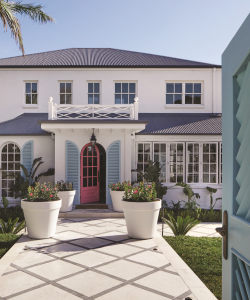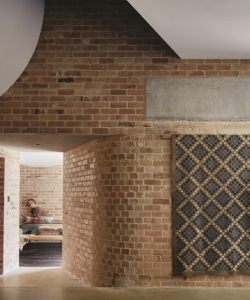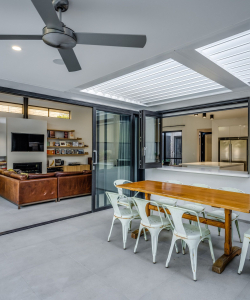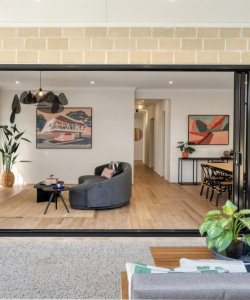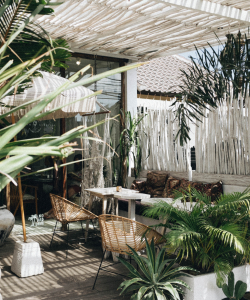
Picture: Claire McFerran, Gathering Light Photography
What exciting design trends do you foresee making a splash in the months and years ahead?
There will be more home integration. Making everything in your home easier for function and use, such as automatic blinds, built-in charging drawers for electronics, built-in seamless storage.
Home zoning is also a big part of home design – we are now seeing more zones created for each member of the family. A sanctuary space to escape while in lockdown, and even after lockdown, still your own space to relax and unwind.
Relaxed living is still here to stay. Barefoot luxury is already a huge movement and this will continue.
Colour palette wise, I am seeing pops of yellow coming into homewares and hard finishes such as tiles. Yellow is the colour of happiness. It’s proven to chemically change our cortisol levels when we look at it, so it’s no wonder we want our homes to make us feel happy.
The Pantone colour of the year for 2021 was a yellow, and now we see why.
Tactility is also a massive factor in trends. We are so used to all working on computers with flat square screens, TVs are flat, all our office working surfaces are so flat with no texture or tactility and we now live in an age where sterility is so important. When we arrive home, we need tactility in our life to juxtaposition our visual day of flat screens and computers.
We are introducing tactility in laminates, cabinetry, flooring, fabrics, soft furnishings and homewares. We’re seeing ceramics are rough, textured, organic shaped. Everything we bring into our clients’ homes has these elements of tactility.
Forms are now heavily moving towards rounded objects. The rounded smooth, circular lines give us a sense of calm in our homes. And it’s a great way to be creative too. Throughout cabinetry and furniture design, creating rounded forms rather than the typical architectural square is the new norm and will continue to be for many years to come.
Did you notice whether people’s direction for the look and feel of their home changed in response to the pandemic?
Absolutely! People weren’t travelling, so they had spare time to update areas of their home which they weren’t particularly loving.
The biggest shift I have seen is in storage. They have accumulated a lot of “stuff” in their lifetime and the house just doesn’t function for everyday living. So we are creating more functional spaces incorporating storage and optimising use of space for home offices in dining rooms, guest rooms and kids’ activity rooms.
Home offices are now part of everyone’s homes, and even with the pandemic hopefully being over, businesses can see the benefit of staff working from home periodically. Nearly every client we are meeting wants a home office for one or two people incorporated somewhere in their home. Some want it in the living space so they can still keep an eye on the kids while working.
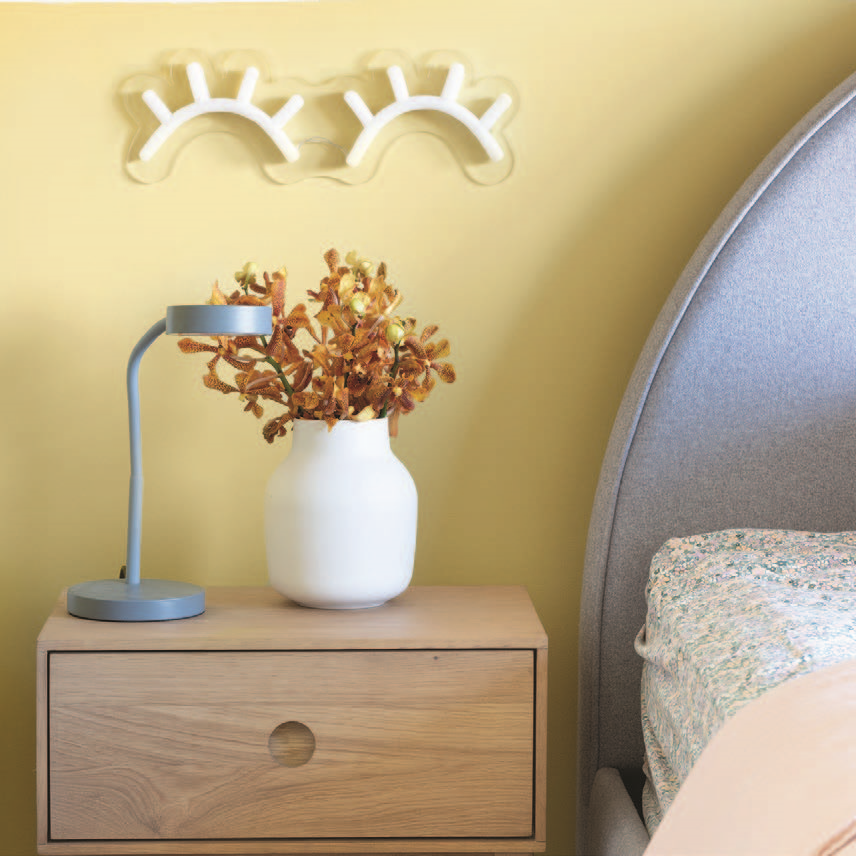
Picture: Claire McFerran, Gathering Light Photography
What advice do you give clients who might be unsure of their own personal style and need help to define it?
I find Pinterest is such a great tool to be able to look at your own personal style on a larger scale. Create a mood board of everything you like in your new home, then look for the common denominator, whether it be the flooring colour, overall colour palette, lighting, sofa, kitchen designs – what’s the same elements that have popped up over and over again?
You don’t need to name your personal style, as there is so much crossover now with styles, but making sure your visual mood board is consistent will give you confidence moving forward to what you want to achieve and that it will work well together.
Is it necessary to have a style preference?
I find every single client has their own personal style, so trying to copy what you see on Instagram or Pinterest or in the magazines isn’t going to give you the outcome you desire.
I do think that you do need to have a style preference. Whether it be contemporary or classic, coastal or rural, luxury or relaxed living, your personality and lifestyle should impact the style of your home.
So have a good look at your hobbies, favourite places you like to visit, type of bars and restaurants you like going to, type of holidays etc. This will give you guidance as to what style suits you.
You do also need to consider the existing architecture of the home, which might not suit your style. If not, it’s time to renovate!
In the world of interior design, what sort of finishes, textures and features would you say are timeless?
You can never go wrong with natural finishes, such as stone, timbers, linens and wool rugs. I think about natural stone materials used throughout the world, they may have been used for a hundred years, and they are so gorgeous and classic. Investing in the right stone and timbers will absolutely give you longevity to your project.
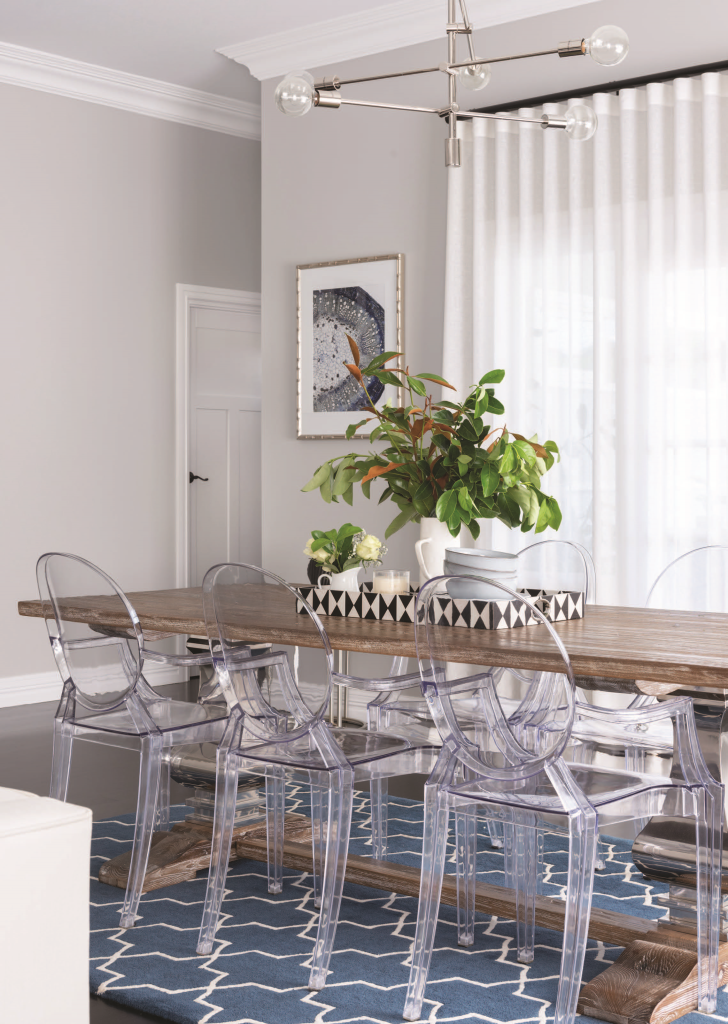
Pictures: Claire McFerran, Gathering Light Photography
Is it possible to future proof your home design decisions so that you don’t fall victim to trends that become dated? If so, how would you go about that?
It’s always a tricky one. We have so many clients who say, “we want to play it safe as we’re scared something we choose will date”. It’s actually the opposite. Playing it safe can date your home because you are choosing finishes that are at the end of the design trend cycle. The market has been saturated with this design but we seem to think choosing it will be the safe option.
What I would rather see is clients choosing something they absolutely love. Something that makes their heart sing when they walk in.
Keeping ahead of the trend by engaging with a great interior designer who can help navigate the process of “timeless design” is absolute key to keeping it timeless.
Maintaining the heritage architectural features of an existing old home is also key, while matching them to modern statement pieces of furniture will ensure longevity of your home and furnishings.
If you could work with any colour palette, finish and style, what would it be and why?
I am absolutely loving lilac at the moment. I have for years but it’s only recently the homewares are keeping up with this trend.
I love using colour and sustainable design pieces so for me, that is more important, choosing ethically for the environment rather than a certain style.
If I did have a choice, I would love a client who absolutely loves a modern farmhouse look. I love the country and this would be my own style more than anything. Lots of natural products, stone floors, oak timber cabinets, natural limestone and lots and lots of large windows to capture the countryside.
I would also love to do something really eclectic. Think a heritage home but with lots of Mediterranean pattern, bold colours in furniture and walls, eclectic homewares and bespoke fabrics. The more pattern, the better!
What can people achieve by getting an interior designer on board and at what stage in a project should they do that?
We can help in so many ways. Confidence, creativity, vision, save time, save money. I find most clients struggle with making decisions, not sure if something will work in their space, or what is actually possible, they might not be creative people at all.
That’s where an interior designer will think outside the square, create functional solutions all while also making the space beautiful.
We also save our client time. Something that might take weekends of window shopping leading to more indecisiveness, we can do in a few hours.
The best time to engage an interior designer is in the planning stage. Either planning the new build or renovation, before you have even started looking into fixtures and fittings or what furniture you like. Right at the beginning we can help bring clarity to the process, help with budget, and also discuss design solutions you haven’t considered.
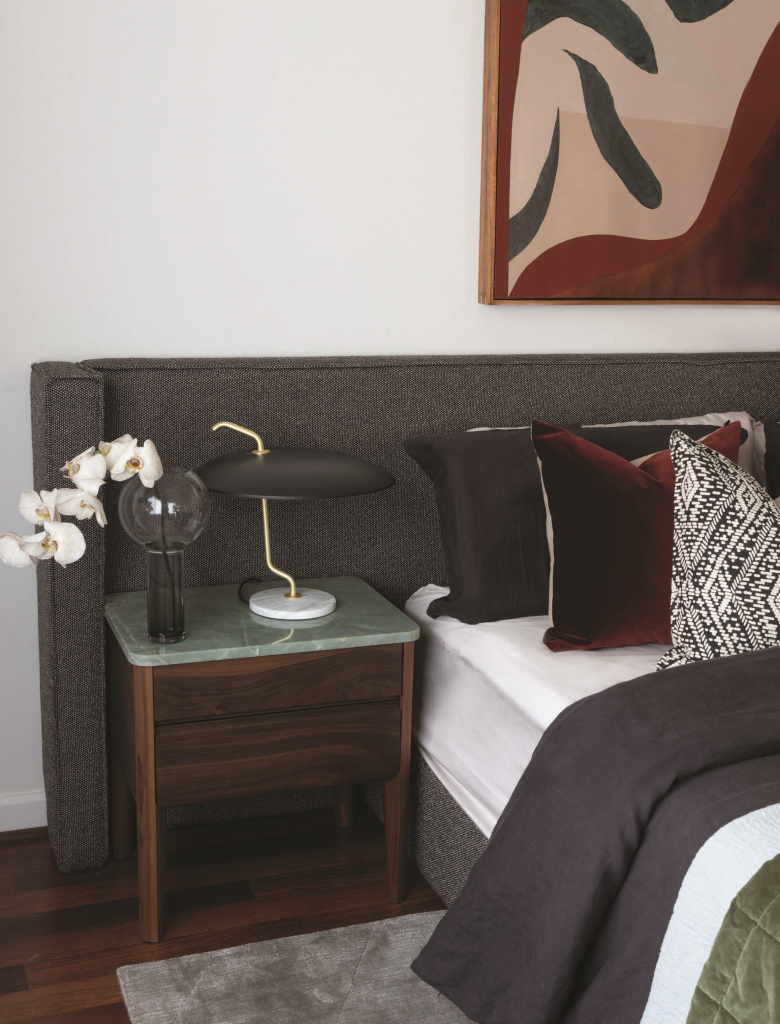
Pictures: Claire McFerran, Gathering Light Photography
What sort of decisions can an interior designer help with and what are the most exciting/crazy/fun things you have ever helped a client to achieve?
We can help selecting the hard finishes for a new build or renovation, inside and out, we can help with cabinetry design, making a kitchen space more functional, deciding on all furniture pieces, space planning, how to utilise a space to its maximum and even how much storage you need.
We have worked with some crazy, crazy client ideas, usually it’s about honing them in and making them more functional.
We have designed some fun bunk bed options for kids. When Covid-19 hit, we had three families all at the same time say their kids now want to sleep in the same room together which is really sweet, it brought the kids closer. I did love creating some really bright and colourful kids rooms during Covid-19, I also enjoyed creating home study options.
What areas of design should people definitely splurge on? Where can they save?
Spend on your kitchen finishes and functionality. Save on floor plan size. What I mean by this is that I have loads of clients building massive houses and they don’t even know how to utilise the space. Yet they can’t afford to put full-height tiling in the ensuite, or upgrade their appliances or front door handles.
For me, it’s not about the size of the home, it’s about utilising the space you have to its fullest potential. So next time you plan your home design, really consider the dead spaces and if you really need them, because you’re paying a lot for them.
What things most often trip people up in the interior design process? What are the common mistakes you have seen?
Most clients I see buy furniture for the sake of buying furniture. It drives me crazy! They need some new furniture and find the process overwhelming and time consuming so just buy something for the sake of buying it, rather than accepting the process may take months, even years.
They also buy cheap just to “get by” until they see the one they love. But they forget to keep looking, and end up living with something for 10 years that they hate.
So my advice to people is to take your time, invest in good-quality statement pieces that you will cherish for 20 years. Don’t waste your money on cheap furniture, wait and invest in something you absolutely love, you will enjoy it so much more.
When it comes to colour, is it possible to proceed with wild abandon? Are neutrals still king?
It all comes down to personal taste and personality. I would love a client to be open to colour, colour, colour but it does depend on personality.
A neutral base is still the safest option if you do want to change out items over the coming years but introducing the right colour for your lifestyle is key to bringing your house to life. Without colour, there is no personality.
What are the trickiest design briefs to pull off?
I would say a family who can’t decide between themselves collectively what they like. Navigating the relationships and process of design can be difficult if the couple aren’t in agreeance with the design brief. So they really do need to be on the same page.
What do you most love about your job?
So much to love! The ever-changing industry, there is always something new and exciting to find. The innovation of suppliers and products keeps me driven and open to educating myself and the team. Seeing the final product, seeing our vision come to life and how content it makes our clients is a lovely part of the process.
